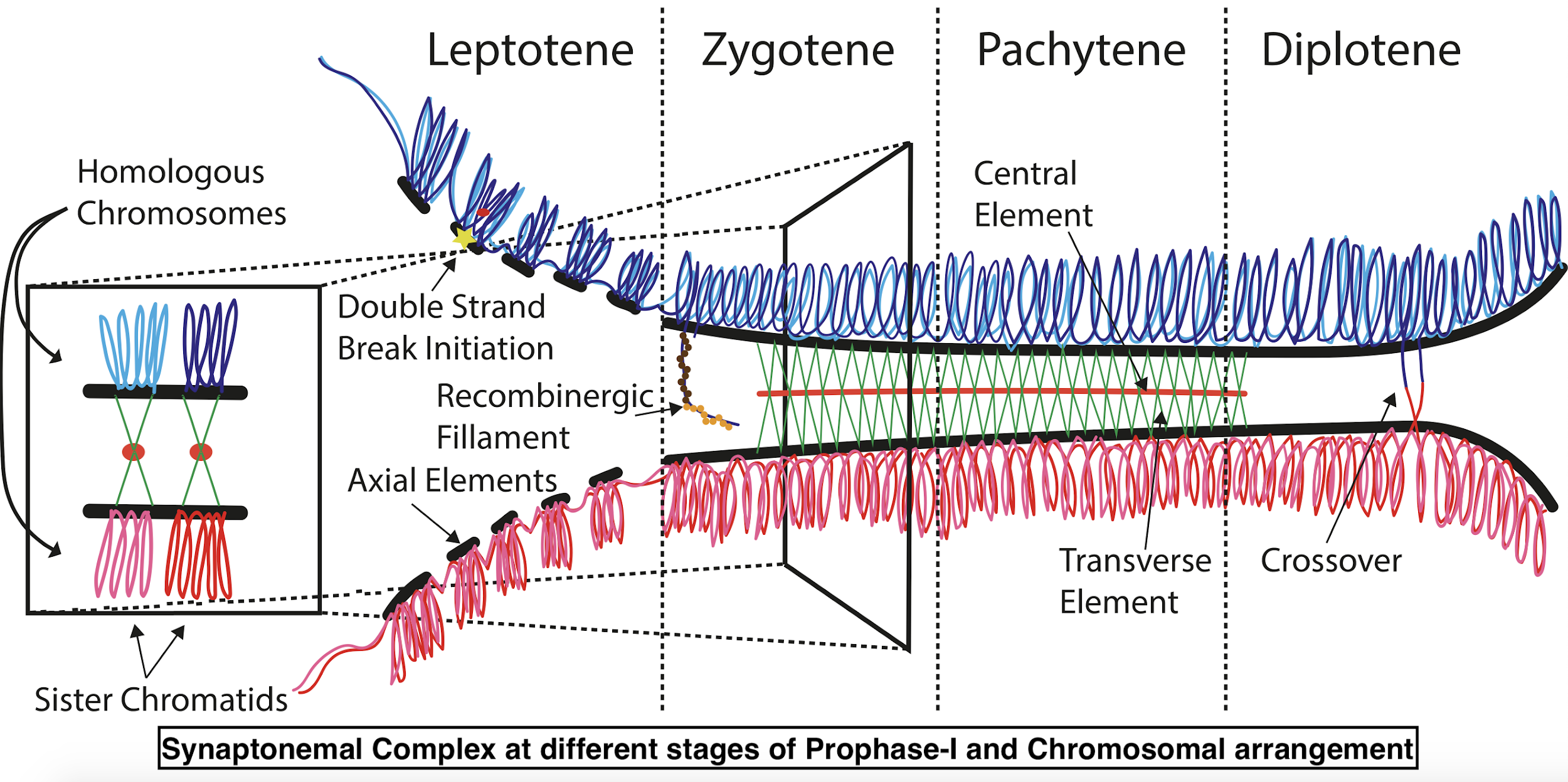
In a cell cycle crossing over occurs at
(a) Single strand stage
(b) Two strand stage
(c) Four strand stage
(d) Eight strand stage
Answer
472.2k+ views
Hint: Crossing over is the mutual exchange and reciprocal recombination of chromatid segments, DNA fragments, or block of genes between the non-sister chromatids of homologous chromosomes. Crossing over occurs during prophase I of meiosis before tetrads are aligned along the equator in metaphase I. Only two of the four chromatids are involved in Crossing over.
Complete answer:
In a cell cycle, crossing over occurs at the four-strand stage. Crossing over involves the symmetrical breakage of chromatids, and the reciprocal exchange and crosswise reunion of segments between non-sister chromatids, often breaking linkage. This results in the recombination of genes. Crossing over occurs at the pachytene stage of prophase I of Meiosis I.

During the pachytene, stage one chromatid of each homologue overlaps or crosses over a corresponding non-sister chromatid of the other homologue at one or more points. These crossing points are called chiasma. At this point, the non-sister chromatids divide transversely with the help of endonuclease. The broken segments are then mutually exchanged by them. Each exchanged segment fuses with a corresponding portion of non-sister chromatids with the help of ligases. The whole process which involves the breakage, mutual exchange, and reciprocal reunion of chromosome segments is called crossing over.
Additional Information:
- Crossing over and the independent assortment of alleles are the major mechanisms for producing new, non-parental gene combinations and genetic variations.
- Natural selection acts upon these recombinant genotypes and genetic variations and thereby enhances the fitness, survival value, and evolutionary potentiality of organisms.
- In eukaryotes, crossing over may be mitotic or meiotic. Mitotic crossing over occurs in somatic cells and finial cells.
So, the correct answer is the '(c) four-strand stage’.
Note:
- Mitotic crossing over involves five major events; synapsis of homologous chromosomes and tetrad formation, crossing over of non-sister chromatids and chiasma formation, symmetrical breakage of non-sister chromatids, reciprocal recombination through the mutual exchange and crosswise reunion of broken segments, dissociation of the homologues by the decriminalization of chiasma.
- Synapsis is the close pairing of homologous chromosomes during the zygotene stage of the first meiotic division.
- Double-crossing over is the crossing over which involves two chiasma, two, three, or four chromatids.
Complete answer:
In a cell cycle, crossing over occurs at the four-strand stage. Crossing over involves the symmetrical breakage of chromatids, and the reciprocal exchange and crosswise reunion of segments between non-sister chromatids, often breaking linkage. This results in the recombination of genes. Crossing over occurs at the pachytene stage of prophase I of Meiosis I.

During the pachytene, stage one chromatid of each homologue overlaps or crosses over a corresponding non-sister chromatid of the other homologue at one or more points. These crossing points are called chiasma. At this point, the non-sister chromatids divide transversely with the help of endonuclease. The broken segments are then mutually exchanged by them. Each exchanged segment fuses with a corresponding portion of non-sister chromatids with the help of ligases. The whole process which involves the breakage, mutual exchange, and reciprocal reunion of chromosome segments is called crossing over.
Additional Information:
- Crossing over and the independent assortment of alleles are the major mechanisms for producing new, non-parental gene combinations and genetic variations.
- Natural selection acts upon these recombinant genotypes and genetic variations and thereby enhances the fitness, survival value, and evolutionary potentiality of organisms.
- In eukaryotes, crossing over may be mitotic or meiotic. Mitotic crossing over occurs in somatic cells and finial cells.
So, the correct answer is the '(c) four-strand stage’.
Note:
- Mitotic crossing over involves five major events; synapsis of homologous chromosomes and tetrad formation, crossing over of non-sister chromatids and chiasma formation, symmetrical breakage of non-sister chromatids, reciprocal recombination through the mutual exchange and crosswise reunion of broken segments, dissociation of the homologues by the decriminalization of chiasma.
- Synapsis is the close pairing of homologous chromosomes during the zygotene stage of the first meiotic division.
- Double-crossing over is the crossing over which involves two chiasma, two, three, or four chromatids.
Recently Updated Pages
The correct geometry and hybridization for XeF4 are class 11 chemistry CBSE

Water softening by Clarks process uses ACalcium bicarbonate class 11 chemistry CBSE

With reference to graphite and diamond which of the class 11 chemistry CBSE

A certain household has consumed 250 units of energy class 11 physics CBSE

The lightest metal known is A beryllium B lithium C class 11 chemistry CBSE

What is the formula mass of the iodine molecule class 11 chemistry CBSE

Trending doubts
Why was the Vernacular Press Act passed by British class 11 social science CBSE

Arrange Water ethanol and phenol in increasing order class 11 chemistry CBSE

Name the nuclear plant located in Uttar Pradesh class 11 social science CBSE

What steps did the French revolutionaries take to create class 11 social science CBSE

How did silk routes link the world Explain with three class 11 social science CBSE

What are the various challenges faced by political class 11 social science CBSE




